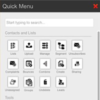Lead Source Tagging
Tracking
At a high level, it’s possible to add parameters to a website URL to pass along important information. This is done using UTM codes (Urchin Traffic Monitors). UTM codes are parameters that are added to a website link URL to allow marketers to identify the traffic source, campaign, and optionally which content or ad copy the visitor followed to arrive on their website.
What are the UTM codes
There are 5 standard UTM codes in use:
- utm_source = identifies which website the visitor is coming from (e.g. Google)
- utm_medium = identifies what type of link was followed (e.g. ppc, email, social)
- utm_campaign = identifies the marketing campaign behind the link (e.g. spring_sale)
- utm_term = (optional) identifies the search term used (e.g. running+shoes)
- utm_content = (optional) identifies which ad content the visitor clicked on. Often used in A/B testing of ad copy, or of the location of the ad
What it looks like in use:
If we are running a campaign to support our Spring Sale on Facebook, our link might look like this:
http://website.com?utm_source=Facebook&utm_medium=social&utm_campaign=spring_sale
These parameters then get “passed on” to the form on our website, so that when a user fills out the form, we can capture this information in the background. This lets us analyze the effectiveness of our campaigns and measure channel ROI.
How to start collecting this data
Using itracMarketer forms:
If you’re utilizing forms from the itracMarketer system, all you have to do is start creating these links and placing them on the different channels you intend to use. The system is already configured to capture lead source from the link, and then save it to the contact’s profile in your database. Other utm parameters can also be accommodated.
Using third-party forms:
If you choose to utilize a third-party form provider (such as: GravityForms, Wuufoo, or many others) there will be additional steps required:
- The same UTM codes are required on your website links to capture the appropriate source, medium, etc.
- You may have to add additional code to the webpage to “capture” the parameters from the URL and record them to the form.
- You may have to create additional (hidden) fields in your form to contain each of the utm code parameters.
- You will want to ensure that this information, once captured on the form, is sent to your itracMarketer contact database by utilizing a WebHook.
We strongly recommend utilizing itracMarketer forms as they are already configured to capture lead source and record it automatically.









